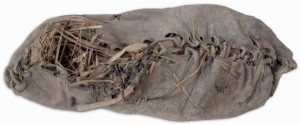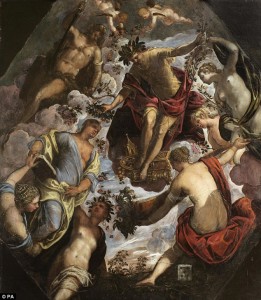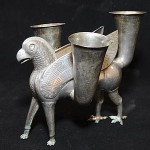It’s 5,500 years old and so well-preserved that the doctoral student Diana Zardaryan, who found it during a dig in a cave in Armenia, at first thought it was a whole cow ear. When she pulled it out of the hole in which a Copper Age walker had carefully placed it thousands of years ago, she saw that it was an intact leather shoe with laces threaded through eyelet.

Radiocarbon dated to about 3500 B.C., during Armenia’s Copper Age, the prehistoric shoe is compressed in the heel and toe area, likely due to miles upon miles of walking. But the shoe is by no means worn out.
Shoes of this age are incredibly rare, because leather and plant materials normally degrade very quickly.
But in this case the contents of a pit in the cave, dubbed Areni-1, had been sealed in by several layers of sheep dung, which accumulated in the cave after its Copper Age human inhabitants had gone.
“The cave environment kept it cool and dry, while the dung cemented the finds in,” said Pinhasi, lead author of the new study, published by the journal PLoS ONE Wednesday.
 The shoe also had additional protection from the elements. Zardaryan found it in a pit lined with yellow clay, covered by an upside-down bowl with two sheep horns on top of it. Those weren’t the only other artifacts scientists discovered in Areni-1. There were obsidian tools, which since the only source of obsidian nearby was was at least 75 miles away, may have been one of the reasons the people who used the cave needed strong shoes.
The shoe also had additional protection from the elements. Zardaryan found it in a pit lined with yellow clay, covered by an upside-down bowl with two sheep horns on top of it. Those weren’t the only other artifacts scientists discovered in Areni-1. There were obsidian tools, which since the only source of obsidian nearby was was at least 75 miles away, may have been one of the reasons the people who used the cave needed strong shoes.
The team also found evidence of ancient winemaking appartus, dried apricots, grapes, plums (possibly the oldest known intentionally dried fruits), plus the skulls of three children or adolescents kept in ceramic pots. One of the skulls even had some brain tissue still in it which was radiocarbon dated to 6,000 years old, 500 years older than the shoe.
 Archaeologists suspect that the cave, first discovered in 1997, was used by high-status members of the community to hold ritual objects, although there is evidence of people actually living in the front of the cave, possibly caretakers who saw to the proper preservation and protection of the ritual objects.
Archaeologists suspect that the cave, first discovered in 1997, was used by high-status members of the community to hold ritual objects, although there is evidence of people actually living in the front of the cave, possibly caretakers who saw to the proper preservation and protection of the ritual objects.
The previous record-holder for oldest leather shoe was our old friend Otzi the Iceman’s kicks (the museum website hasn’t let go of the title yet, this news is so fresh), but they’re 200-300 years younger than the Armenian shoe. They’re also considerably more complex, made from bearskin soles, deerskin side panels, bark-string netting which pulled tight around the foot and grass socks. There are older shoes — some 7,000-year-old examples were found in Missouri and Oregon — but they’re made out of plant fibers, not leather, and they’re sandals rather than full coverage shoes.





